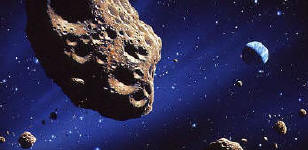






| Website Stats |
Visits from over |
|
Free downloads |
You can now read the material from this website on most electronic devices: -On your computer
Two NEW books from the author of BibleHelp
|
UFOs -7: Problems Detecting Objects in its Path (Part 7 of 8)
Back

Chapter: 11.13
(Section 11: Understanding God and His Universe)
Copyright © Michael Bronson 1997, 1999, and 2000
BibleHelp.org
Summary
Traveling at ultra high-speeds make detecting objects in your path virtually impossible. If you are traveling near the speed of light, any radar signal you send out will be traveling only slightly faster than your spaceship.
For example, let's say that a car is traveling near the speed of sound and honks its horn. By the time the sound reached the intended target (an other car), the high-speed car would also be there.
Click Here for a book version of this material
Detecting objects in outer space is much more difficult than what most people realize. There are two basics ways of detecting objects: Visually and electronically. When we drive slow vehicles (like cars) we rely entirely on our vision to keep us from running into objects. Visual detection, however, is totally useless in ultra high-speed space travel.
Apart from the small white dots (distant stars) there is no light in outer space. It is so dark out there that a spaceship could be heading straight toward a large boulder and the pilot would never see it. Even if the spaceship had headlights, the pilot still wouldn’t be able to see the boulder because the spaceship would be traveling hundreds (or even thousands) of miles a second.
The only other way of detecting objects in the path of the spaceship is to use some type of electronic scanning device (such as a specialized form of radar). Basically, this scanner would send out a signal (at the speed of light) and the signal would bounce back if there is something in its path.
There are, however, a couple major limitations with scanners being used on ultra high-speed vehicles. First, scanners will never be sensitive enough (at these distances) to be able to detect small objects like dust, individual grains of sand, or small pebble. Therefore, the spaceship would always be vulnerable of being punctured by these small objects. Second, ultra high-speeds greatly reduce the range and effectiveness of scanners.
To illustrate the limitations of scanners, let’s study what will happen to a spaceship traveling at half the speed of light (93,000 miles per second). Let’s say this spaceship has an incredibly powerful and sensitive scanner that is able to detect a boulder (the size of a TV) at 10,000 miles. To put this into perspective, that would be the same as a scanner being sensitive enough to be able to detect a grain of sand at 10 miles. Even with this powerful long-range scanner, the pilot would have less than 4/100th of a second to be able to respond.7.1 The chart below provides for a graphical view of this problem.
|
1 |
|
|
2 |
|
|
3 |
|
|
4 |
|
Data table for the above diagram
|
Step |
Comment |
Distance to the boulder (miles) |
Time laps for each step (seconds) |
Total time laps (seconds) |
|
1 |
Spaceship (traveling at half the speed of light) sends out a signal traveling at the speed of light. |
10,000 |
0 |
0 |
|
2 |
The signal reaches the boulder. |
5,000 |
.053765 |
.053765 |
|
3 |
The signal reaches the spaceship after being bounced back. |
3,333 |
.017900 |
.071605 |
|
4 |
The spaceship reaches the boulder. The pilot has .0358 seconds to respond once the boulder has been detected. |
0 |
.035800 |
.107405 |
People often assume that light travels instantaneously from one location to another. While it appears instantaneous to us in most of our everyday situations, it does take time for light to travel from one spot to another. When you consider the gigantic size of the universe, light actually travels very slowly. In fact, if the "known" universe was shrunk down to the size of earth, light would appear to be traveling at the rate of 1.9 inches every 100 years. That’s about the width of a hair every year.7.2
This "slowness" of light becomes more apparent as the spaceship increases its speed. In the above scenario, the spaceship will have traveled two-thirds of the way to the boulder before it is notified that the boulder is there. By then the pilot has very little time to respond.
Of course, even if the scanner signal did travel instantaneously, there still wouldn’t be enough time for the pilot to respond. Traveling at half the speed of light, the spaceship would travel the 10,000 miles in 1/10th of a second.
Some people say that even though human pilots can’t respond this quickly, computerized piloting could. Even if this were true, the scanner still doesn’t know exactly where the boulder is located. It only knows that thousands of miles away, there is a boulder very close to its projected path.
To illustrate this problem, go outdoors and stretch your hand out above your head. Now, pretend you are holding a grain of sand between your fingers. Behind the grain of sand is a very small piece of sky (about 1mm wide). Let’s say that the narrow signal being sent out by the spaceship’s scanner is so highly focused that it is only scanning an area the size of that small piece of sky. At 10,000 miles, that small area is actually an area that is 14 by 14 miles wide.7.3
To help you visualize this phenomenon, cut a 1-inch hole in a piece of paper. Hold the paper at arm’s length and look at a person through the hole. If the person is nearby, you can only see his head. If the person is farther away, you would be able to see his whole body. If he is very far away, the person would appear as a dot. This expansion is what’s happening when the scanner is scanning a piece of sky the size of a grain of sand.
When the scanner tells the pilot that a boulder has been detected, it is only telling the pilot there is a boulder somewhere near his projected path (somewhere in the 14 x 14 mile zone). How does a pilot (or computer) respond to that? The only option is to slightly alter the ship’s course to avoid the danger zone. The spaceship will have to move up or down (or left or right) at least seven miles to get away from the danger zone.
Although this would seem like a simple thing to do, this flight adjustment produces two serious problems. First, the pilot (or computer) would be moving from a "danger zone" to an "unknown zone." The pilot has no idea what lies ahead in the area he is moving into. The unknown zone could be completely safe or it could be filled with even larger boulders. The second problem is this slight corrective action will produce a very abrupt movement for the spaceship and its occupants. This problem will be discussed in the next chapter.
Footnotes: The footnote section for the UFO chapters has 10 pages of calculations. I have, therefore, put all of the footnotes and calculations on another web page to keep these web pages cleaner looking. Click on the link below to go to the footnotes:
Other Chapters in this Section
Home
Tell a Friend about this page

